Cities offer wildlife perfect nesting conditions through abundant food sources, artificial structures that mimic natural habitats, and reduced predator threats. You’ll find skyscrapers serving as cliff substitutes for peregrine falcons, while bridges shelter swallows and starlings. Urban areas provide warmer temperatures, extending breeding seasons, and various water features support diverse species. Green spaces create essential biodiversity islands within concrete landscapes. Discover how these urban advantages create surprisingly successful wildlife havens.
Abundant Food Sources: Urban Buffets for Nesting Birds

While we often think of cities as concrete jungles hostile to wildlife, urban environments actually offer surprising bounties for nesting birds. Your backyard garden, nearby parks, and ornamental plants create diverse food sources that support native wildlife throughout the seasons.
You’ll notice birds flocking to human-provided resources like bird feeders and fruiting shrubs when raising their young. Cities present unique advantages with less competition for food during nesting season compared to rural settings.
Even waste management inadvertently creates foraging opportunities as birds discover discarded food items.
Research confirms that these abundant food sources contribute to higher nesting success rates in urban areas. As birds feed their chicks with readily available insects and plant materials, they’re finding our cities aren’t just survivable—they’re thriving zones for raising the next generation.
Artificial Structures as Nesting Havens
You’ll notice tall skyscrapers throughout cities mimic natural cliff faces, creating perfect nesting spots for birds like peregrine falcons that prefer elevated perches.
Bridges offer sheltered environments where entire colonies of swallows and starlings can establish their homes away from ground predators.
The abundance of building materials—from twigs in parks to discarded string and paper—provides urban wildlife with ready-made construction supplies for crafting nests in these artificial havens.
Skyscrapers Mimic Cliff Faces
Soaring high above urban landscapes, modern skyscrapers inadvertently create perfect substitutes for the cliff faces many bird species evolved to inhabit.
You’ll notice peregrine falcons particularly thrive in these vertical concrete jungles, using tall buildings as vantage points for hunting in urban areas.
- Ledges and crevices on buildings replicate natural nesting habitats
- Higher nesting success rates due to fewer natural predators
- Abundant food sources support wildlife raising their young
- Species like rock pigeons and starlings have fully adapted to building-nesting
- Artificial structures have contributed to population recovery of endangered species
The relationship between skyscrapers and birds demonstrates remarkable adaptation, as these structures have become essential to wildlife conservation.
Peregrine falcon populations have greatly increased thanks to these unintentional sanctuaries towering above our busy streets.
Bridges Shelter Colonies
The massive concrete and steel spans that connect our urban landscapes serve as unexpected wildlife havens throughout cities worldwide.
You’ll find bridges offer perfect shelter for diverse urban wildlife, with their numerous ledges, crevices, and protected spaces mimicking natural habitats.
Swallows and pigeons nestle beneath these structures, safe from predators and harsh weather. The dark, secluded spaces attract bat colonies, which contribute considerably to local biodiversity.
Even peregrine falcons have adapted to hunting from these elevated perches, demonstrating how artificial structures support urban raptor populations.
Beyond providing nesting sites, bridges create essential ecological connectivity, enabling wildlife to move between fragmented habitats.
These architectural marvels unintentionally function as wildlife corridors, helping species disperse throughout urban environments and creating thriving colonies in our concrete jungles.
Building Materials Aid Construction
While nature provides twigs, mud, and grass for nests, urban environments offer a surprising array of artificial building materials that wildlife readily incorporate into their homes.
You’ll find that urban residents like pigeons and swallows have adapted to use construction materials found throughout cities.
- Concrete ledges on buildings mimic natural cliff faces, providing stable platforms for nest construction
- Wooden eaves offer protection from weather elements while retaining warmth
- Green roofs with vegetation create ideal nesting material sources
- Building insulation materials can be gathered by birds to line their nests
- Metal fixtures provide sturdy anchoring points for larger nests
These building materials often provide advantages over natural alternatives—they’re weather-resistant, predator-proof, and maintain consistent temperatures.
As you explore your city, you’ll notice wildlife ingeniously repurposing our human infrastructure into their perfect homes.
Urban Predator Dynamics and Safety Benefits
Urban environments surprisingly offer wildlife a unique advantage when it comes to safety from natural threats.
You’ll notice birds nesting on skyscrapers aren’t just adapting—they’re thriving with higher success rates than their rural counterparts. This shift in urban predator dynamics creates protective havens where fledglings face fewer terrestrial dangers.
Consider peregrine falcons that have transformed city buildings into hunting perches, capitalizing on abundant prey while safely raising their young.
Peregrine falcons elevate urban architecture into strategic advantages, hunting efficiently while creating secure nurseries above the bustling cityscape.
Canada geese populations similarly expand in urban settings where predators are less common.
When cities implement thoughtful wildlife management strategies, they further enhance these safety benefits.
The resulting balance creates an unexpected sanctuary effect, where the concrete jungle actually shields many species from natural predators—making urban landscapes surprisingly hospitable nesting grounds.
Green Spaces: Biodiversity Hotspots Within City Limits
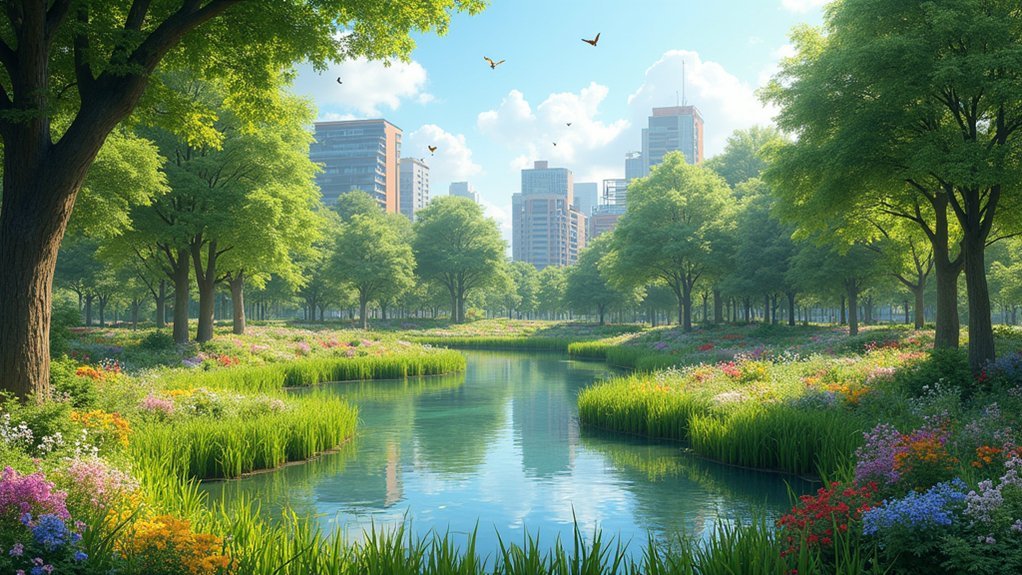
You’ll find that urban parks and gardens function as thriving biodiversity islands, sustaining essential ecological niches amidst concrete landscapes.
These green spaces support remarkable wildlife diversity, from migrating birds resting during seasonal journeys to native pollinators establishing permanent colonies.
Your local park might actually harbor endangered species, with well-designed urban green areas creating important connectivity between fragmented habitats that allows wildlife to flourish despite urbanization.
Urban Biodiversity Islands
Why do concrete jungles often harbor surprising pockets of thriving wildlife? It’s because cities create urban biodiversity islands that function as essential wildlife habitats amid development. You’ll find these ecological sanctuaries in parks, gardens, and even rooftops throughout metropolitan areas.
- Diverse environments like lawns, borders, and vegetable patches cater to different species’ needs.
- Varied plant structures mimic “forest glades,” enhancing biodiversity in unexpected ways.
- Rare species like peregrine falcons adapt to city life, using buildings as cliff substitutes.
- Public greenspaces facilitate meaningful human-wildlife interactions, building conservation awareness.
- Community involvement helps maintain these habitats, ensuring continued ecological success.
These biodiversity islands aren’t just pleasant green spots—they’re critical lifelines for countless species that have adapted to thrive alongside human development.
Nature’s Urban Renaissance
Cities worldwide are experiencing an extraordinary revival of biodiversity through the creation and preservation of green spaces.
You’ll find these urban oases functioning as wildlife corridors that connect previously isolated habitats, allowing animals to move safely throughout the concrete landscape.
What were once vacant lots and unused properties have transformed into thriving ecosystems filled with native plants that attract local insects and other wildlife.
Community gardens and public parks now serve as biodiversity hotspots where you can spot peregrine falcons nesting on skyscrapers and various bird species utilizing the vegetation for food and shelter.
This green infrastructure integration into city planning represents a significant shift in urban development, prioritizing ecological diversity while creating spaces where both humans and wildlife can flourish together.
Temperature Advantages of the Urban Heat Island Effect
While rural landscapes gradually cool at dusk, urban environments hold onto the day’s warmth, creating what scientists call the Urban Heat Island effect.
These temperature advantages in urban areas can benefit wildlife in surprising ways:
- Cities can be up to 22°F warmer at night than surrounding countryside
- Extended breeding seasons allow birds to raise multiple broods
- Earlier plant blooming provides abundant food sources for nesting animals
- Heat-retaining surfaces create favorable microclimates for warmth-loving species
- Urban warmth helps wintering species survive and nest more successfully
You’ll notice these temperature benefits most during severe weather events, when city-dwelling wildlife often weathers storms better than their rural counterparts.
The extra degrees create a buffer against harsh conditions and turn concrete jungles into unexpected wildlife sanctuaries.
Seasonal Nesting Patterns in Metropolitan Areas

The Urban Heat Island effect not only creates temperature advantages but also shapes remarkable seasonal nesting patterns throughout metropolitan areas.
You’ll notice migratory birds strategically utilizing urban green spaces as critical stopover sites during breeding season, often arriving earlier than their rural counterparts.
In urban areas, nesting success rates typically exceed those in surrounding countryside due to reduced natural predation.
Birds adapt their breeding schedules to capitalize on the extended warm periods cities provide, with species like sparrows and finches demonstrating remarkable flexibility in their nesting strategies.
Year-round, you can observe how different species leverage artificial structures and open spaces according to seasonal needs.
Buildings, bridges, and specially designed nesting boxes compensate for natural habitat loss, creating a continuous cycle of avian reproduction that pulses with the changing seasons.
Water Features: Critical Resources for Urban Breeding Success
Flowing through the concrete landscape, urban water features serve as lifelines for countless breeding species that have adapted to city living.
You’ll find these aquatic habitats—from ponds to streams—creating unexpected nesting havens where wildlife thrives despite urban challenges.
- Artificial water bodies in urban areas provide essential nesting sites for ducks, herons, and other waterfowl.
- Clean water quality attracts migratory birds seeking safe breeding grounds with abundant food resources.
- Urban streams support fish populations that sustain hunting birds like kingfishers and falcons.
- Amphibians depend on these water features for both drinking and completing their reproductive cycles.
- Well-managed water habitats greatly improve nesting success rates by offering protection from predators.
When cities prioritize these water resources, they transform concrete jungles into surprising breeding sanctuaries, creating biodiversity hotspots that benefit both wildlife and urban residents alike.
Human-Bird Relationships: When Conservation Meets Urban Living
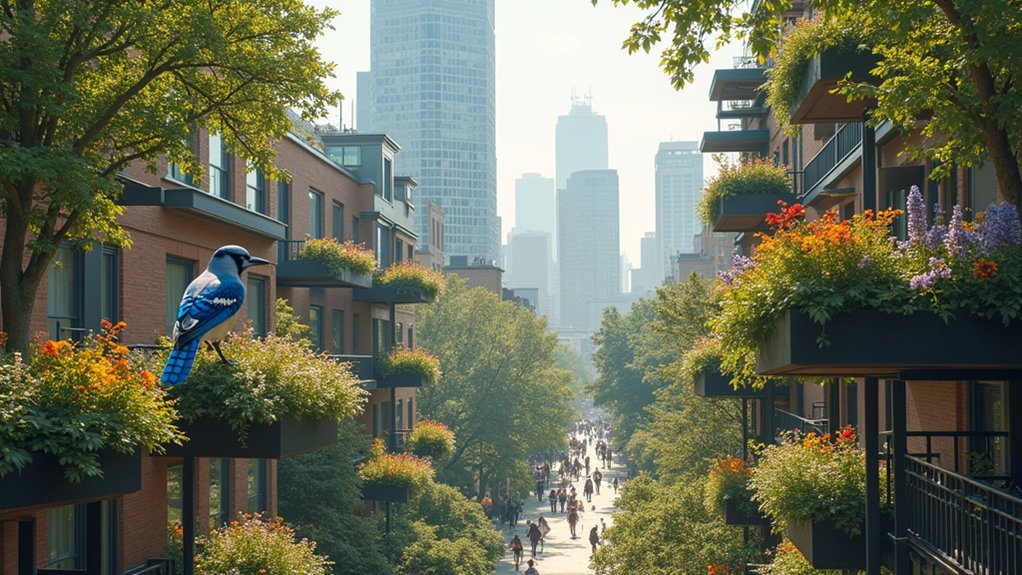
Beyond concrete infrastructure and water features, successful urban wildlife havens depend on meaningful human-bird relationships that form the foundation of city conservation efforts. You’re likely part of this conservation story when you hang a bird feeder or install nesting boxes in your yard.
| Relationship Type | Benefits to Birds | Benefits to Humans |
|---|---|---|
| Active Feeding | Reliable food source | Connection to local animals |
| Nesting Support | Safe breeding sites | Increased biodiversity |
| Education | Protected habitats | Environmental awareness |
| Citizen Science | Population monitoring | Community engagement |
Urban residents who participate in bird-friendly practices contribute to higher nesting success rates in cities than in rural areas. Conservation programs now emphasize coexistence strategies, teaching you how to appreciate peregrine falcons nesting on skyscrapers and songbirds in your garden—transforming cities into thriving wildlife sanctuaries.
Adapting Garden Spaces to Support Successful Bird Breeding
While urban landscapes often appear hostile to wildlife, your garden can become a critical breeding ground for birds seeking sanctuary in concrete jungles.
Amidst urban sprawl, your garden offers vital refuge where birds can nest, breed, and flourish.
By transforming your outdoor space into natural habitats, you’ll create places for wildlife to thrive during nesting season.
- Install nesting boxes and plant dense hedges to provide essential breeding sites
- Select plants offering year-round nectar and pollen to attract diverse bird species
- Leave autumn leaves and create dense vegetation patches for protection from predators
- Plant fruiting shrubs to feed migrating birds and encourage them to stay and breed
- Implement modern feeding techniques to attract up to 80 different wild bird species
These simple adaptations can turn your garden into a vibrant breeding haven, helping birds successfully raise their young despite urban challenges.
Frequently Asked Questions
How Can Cities Incorporate Green Areas to Protect Wildlife?
You can create wildlife-friendly cities by adding parks, planting native species, designing green corridors, involving communities in conservation, and adopting sustainable landscaping practices that minimize chemical use and promote biodiversity.
Why Are Cities Refuges for Some Wildlife?
Cities become wildlife refuges because they offer abundant food sources, fewer natural predators, and diverse nesting sites on buildings. You’ll find these urban environments also provide protected green spaces where animals can thrive safely.
Why Do Some Species Thrive in Cities?
You’ll find species thrive in cities due to abundant food sources, fewer predators, suitable nesting structures, and diverse habitats. They’ve adapted to use human waste, garden vegetation, and urban green spaces to their advantage.
How Can We Make Cities More Animal Friendly?
You can make cities more animal friendly by planting native gardens, creating wildlife corridors, involving communities in green space projects, designing wildlife-friendly buildings, and limiting pet access in designated wildlife areas.
In Summary
Cities aren’t just for humans—they’re thriving havens for wildlife too. You’ll find birds and animals adapting brilliantly to urban environments, using our buildings as cliffs, feeding on our food waste, and enjoying warmer temperatures year-round. By understanding these adaptations, you’re better equipped to create wildlife-friendly spaces in your own backyard, turning your urban environment into a sanctuary for nature’s next generation.
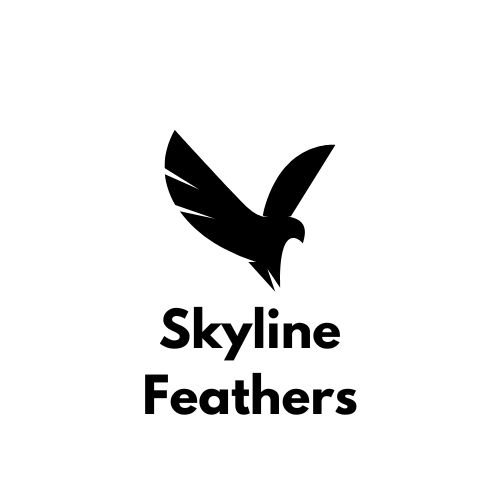

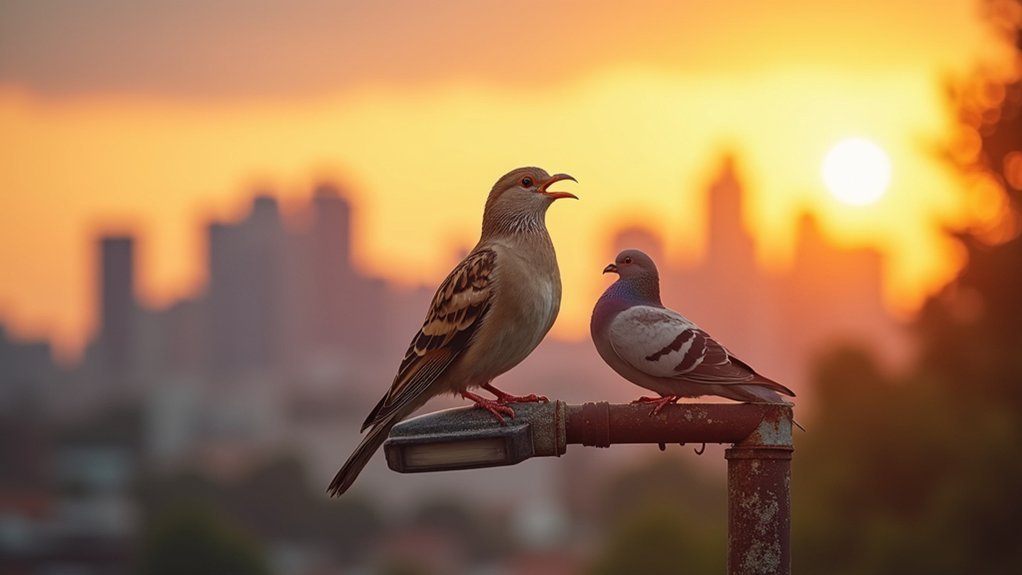
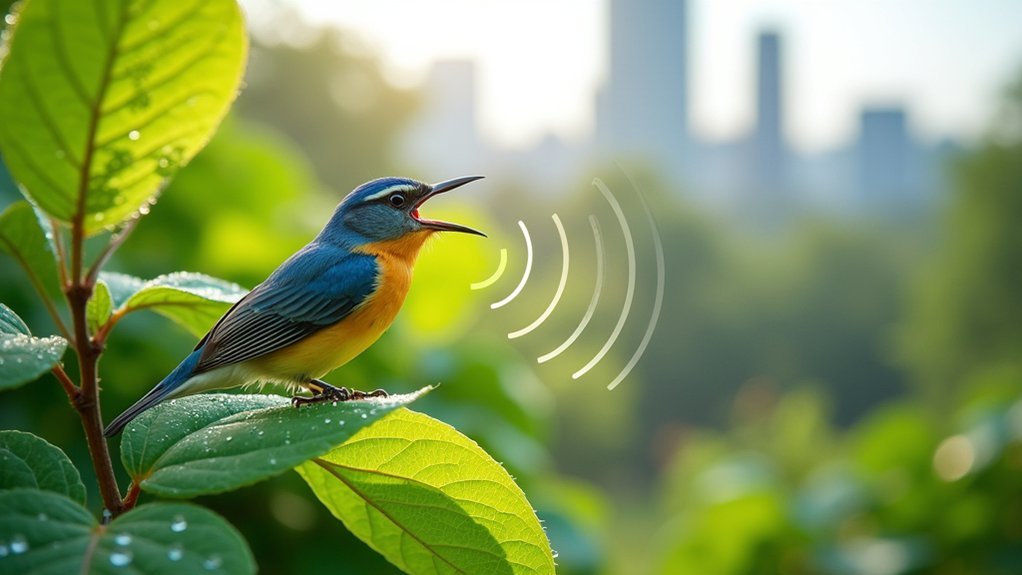
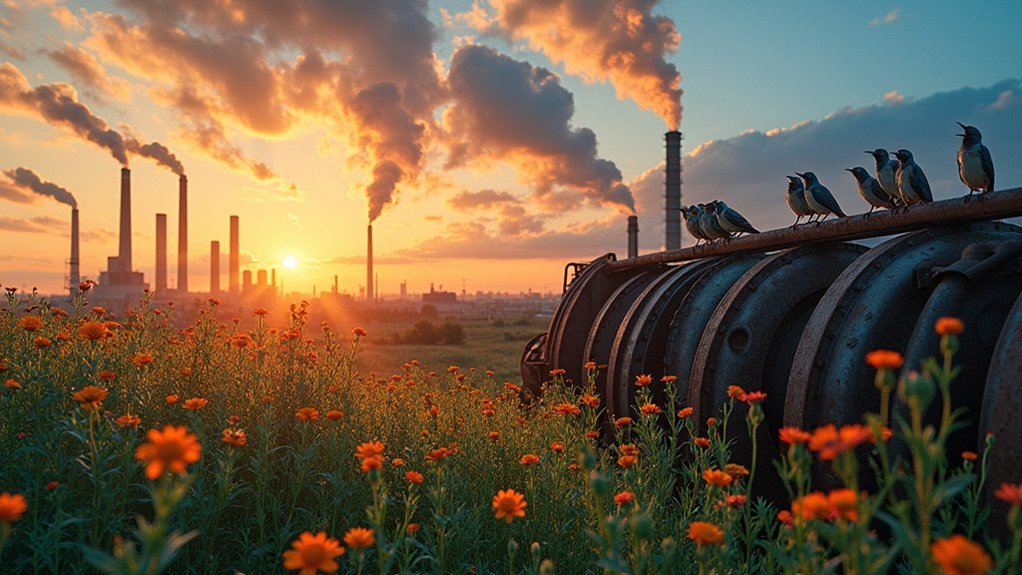
Leave a Reply